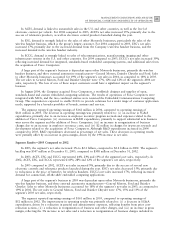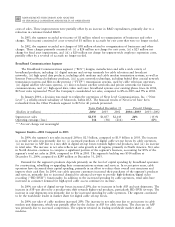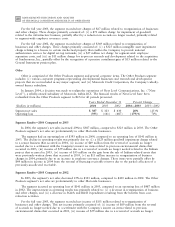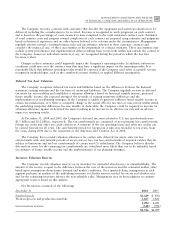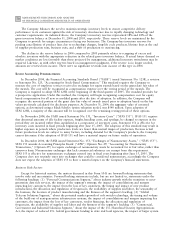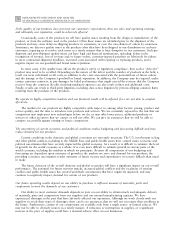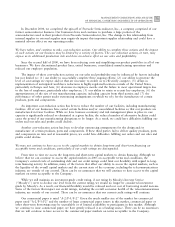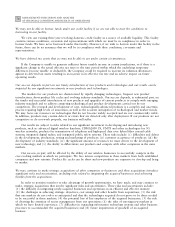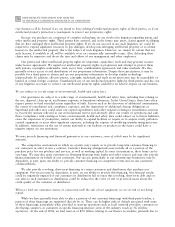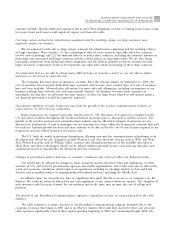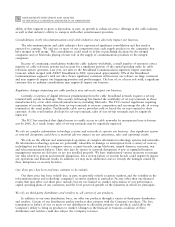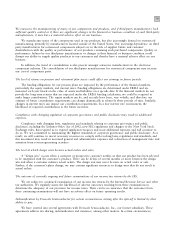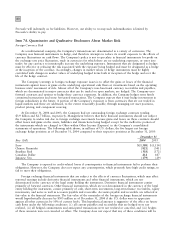Motorola 2004 Annual Report Download - page 79
Download and view the complete annual report
Please find page 79 of the 2004 Motorola annual report below. You can navigate through the pages in the report by either clicking on the pages listed below, or by using the keyword search tool below to find specific information within the annual report.
71
MANAGEMENT'S DISCUSSION AND ANALYSIS
OF FINANCIAL CONDITION AND RESULTS OF OPERATIONS
projects, including on our competitive position, the segment's growth platform, the impact from the loss of key
customers, allocation and regulation of frequencies, the availability of supplies and labor and the Ñrmness of the
segment's backlog; (4) ""Integrated Electronic Systems Segment,'' about the impact from the loss of key customers,
the impact of the segment's strategy, the availability of supplies and labor and the Ñrmness of the segment's
backlog; (5) ""Broadband Communications Segment,'' about future sales of digital products and CMTS products,
the impact from the loss of key customers, the impact of demand and competitive changes, the impact of
regulatory matters, the availability of supplies and labor and the Ñrmness of the segment's backlog; (6) ""Other
Information,'' about the impact from the loss of key customers, the Ñrmness of the aggregate backlog position, the
competitiveness through research and development and utilization of technology; (7) ""Legal Proceedings,'' about
the ultimate disposition of pending legal matters; (8) ""Management's Discussion and Analysis,'' about: (a) the
success of our business strategy in producing improved operating results with our new structure, (b) future
payments, charges, use of accruals and expected cost-saving beneÑts associated with our reorganization of business
programs, (c) the Company's ability and cost to repatriate funds, (d) future cash contributions to pension plans or
retiree health beneÑt plans, (e) outstanding commercial paper balances, (f) the Company's ability and cost to
access the capital markets, (g) the adequacy of reserves relating to long-term Ñnance receivables and other
contingencies, (h) expected payments pursuant to commitments under long-term agreements, (i) the outcome of
ongoing and future legal proceedings, including without limitation, those relating to Iridium and Telsim, (j) the
impact on CGISS of the trend towards larger systems, and (k) the impact of recent accounting pronouncements on
the Company; and (9) ""Quantitative and Qualitative Disclosures about Market Risk,'' about: (a) the impact of
foreign currency exchange risks, (b) future hedging activity and expectations of the Company, and (c) the ability
of counterparties to Ñnancial instruments to perform their obligations.
We wish to caution the reader that the following important business risks and factors, and those business risks
and factors described elsewhere in this report or our other Securities and Exchange Commission Ñlings, could cause
our actual results to diÅer materially from those stated in the forward-looking statements.
The demand for our products depends in large part on the continued growth of the industries in which we
participate. A market decline in any one of these industries could have an adverse eÅect on our business.
Our business was very negatively impacted by the economic slowdown and the corresponding reduction in
capital spending by the telecommunications industry from 2001 to 2003. We incurred sizeable net losses in 2001
and 2002. The rate at which the portions of the telecommunications industry in which we participate improve is
critical to our ability to improve our overall Ñnancial performance.
Our customers and our manufacturing facilities are located throughout the world, and as a result, we face risks
that other companies that are not global may not face.
Our customers are located throughout the world and more than half of our net sales are made to customers
outside of the U.S. In addition, we have many manufacturing, administrative and sales facilities outside the U.S.,
more than half of our products are manufactured outside the U.S. and approximately 55% of our employees are
employed outside the U.S.
As with all companies that have sizeable sales and operations outside the U.S., we are exposed to risks that
could negatively impact sales and/or proÑtability, including but not limited to: (1) tariÅs, trade barriers and trade
disputes; (2) regulations related to customs and import/export matters; (3) longer payment cycles; (4) tax issues,
such as tax law changes, variations in tax laws from country to country and as compared to the U.S., and diÇculties
with repatriating cash generated or held abroad in a tax-eÇcient manner; (5) currency Öuctuations, particularly in
the euro and Chinese renminbi; (6) challenges in collecting accounts receivable; (7) cultural and language
diÅerences; (8) employment regulations and local labor conditions; (9) diÇculties protecting IP in foreign
countries; (10) instability in economic or political conditions, including inÖation, recession, actual or anticipated
military or political conÖicts; (11) natural disasters, such as earthquakes, tsunamis and typhoons, and (12) public
health issues or outbreaks.
Many of our products that are manufactured outside of the U.S. are manufactured in Asia. In particular, we
have sizeable operations in China, including manufacturing operations, and 9% of our net sales are made to
customers in China. The legal system in China is still developing and is subject to change. Accordingly, our
operations and orders for products in China could be adversely impacted by changes to or interpretation of Chinese
law. Further, if manufacturing in the region is disrupted, our overall capacity could be signiÑcantly reduced and
sales and/or proÑtability could be negatively impacted.


